Page 217 of 376
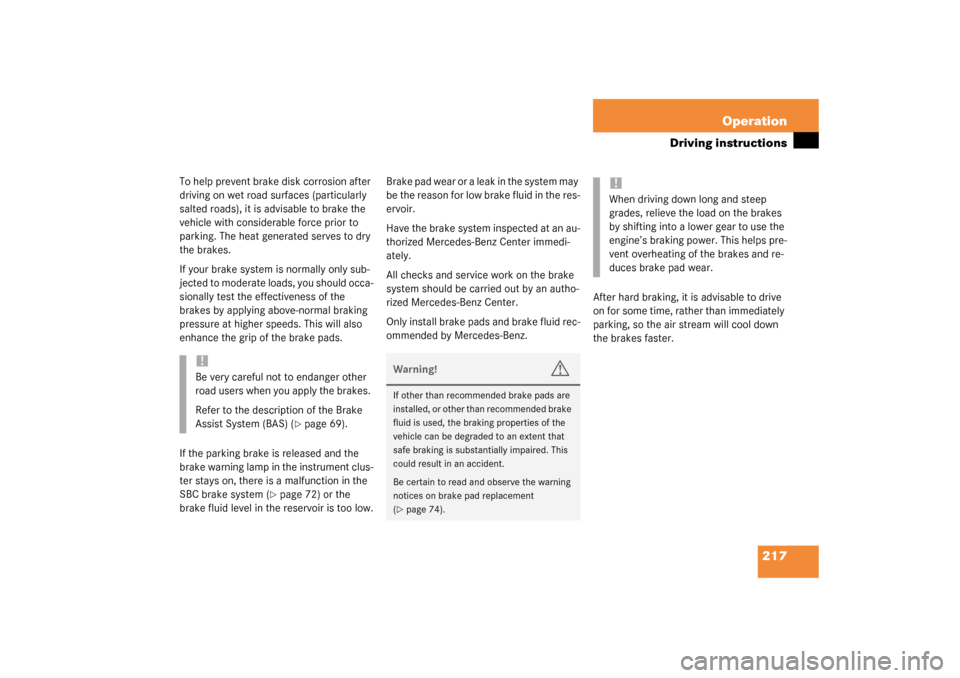
217 Operation
Driving instructions
To help prevent brake disk corrosion after
driving on wet road surfaces (particularly
salted roads), it is advisable to brake the
vehicle with considerable force prior to
parking. The heat generated serves to dry
the brakes.
If your brake system is normally only sub-
jected to moderate loads, you should occa-
sionally test the effectiveness of the
brakes by applying above-normal braking
pressure at higher speeds. This will also
enhance the grip of the brake pads.
If the parking brake is released and the
brake warning lamp in the instrument clus-
ter stays on, there is a malfunction in the
SBC brake system (
�page 72) or the
brake fluid level in the reservoir is too low.Brake pad wear or a leak in the system may
be the reason for low brake fluid in the res-
ervoir.
Have the brake system inspected at an au-
thorized Mercedes-Benz Center immedi-
ately.
All checks and service work on the brake
system should be carried out by an autho-
rized Mercedes-Benz Center.
Only install brake pads and brake fluid rec-
ommended by Mercedes-Benz.After hard braking, it is advisable to drive
on for some time, rather than immediately
parking, so the air stream will cool down
the brakes faster.
!Be very careful not to endanger other
road users when you apply the brakes.
Refer to the description of the Brake
Assist System (BAS) (
�page 69).
Warning!
G
If other than recommended brake pads are
installed, or other than recommended brake
fluid is used, the braking properties of the
vehicle can be degraded to an extent that
safe braking is substantially impaired. This
could result in an accident.
Be certain to read and observe the warning
notices on brake pad replacement
(�page 74).
!When driving down long and steep
grades, relieve the load on the brakes
by shifting into a lower gear to use the
engine’s braking power. This helps pre-
vent overheating of the brakes and re-
duces brake pad wear.
Page 230 of 376
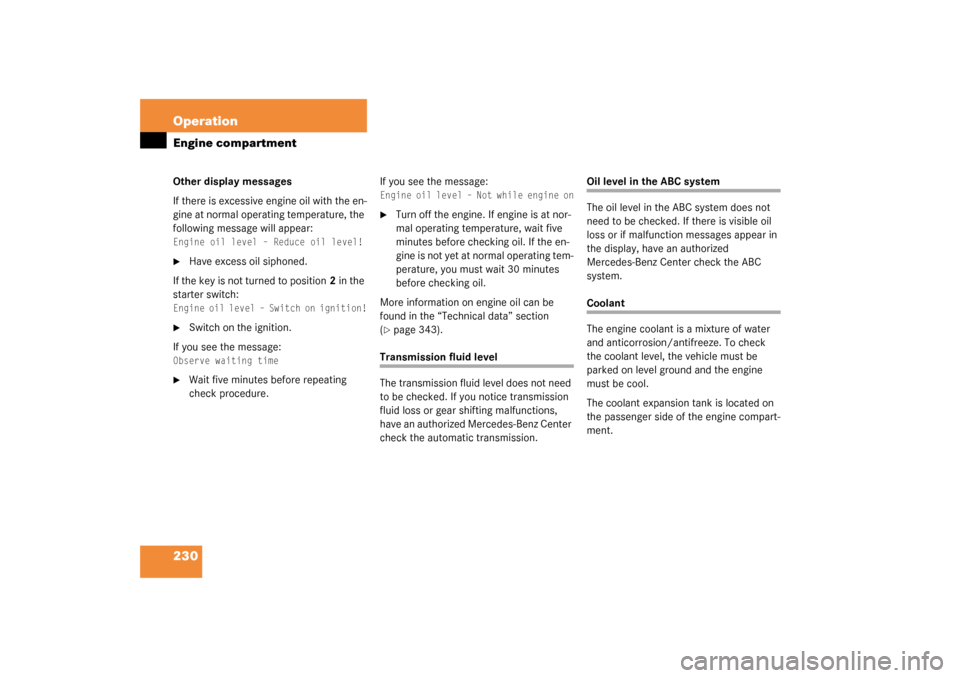
230 OperationEngine compartmentOther display messages
If there is excessive engine oil with the en-
gine at normal operating temperature, the
following message will appear: Engine oil level – Reduce oil level!�
Have excess oil siphoned.
If the key is not turned to position2 in the
starter switch:
Engine oil level – Switch on ignition!�
Switch on the ignition.
If you see the message:
Observe waiting time�
Wait five minutes before repeating
check procedure. If you see the message:
Engine oil level – Not while engine on�
Turn off the engine. If engine is at nor-
mal operating temperature, wait five
minutes before checking oil. If the en-
gine is not yet at normal operating tem-
perature, you must wait 30 minutes
before checking oil.
More information on engine oil can be
found in the “Technical data” section
(
�page 343).
Transmission fluid level
The transmission fluid level does not need
to be checked. If you notice transmission
fluid loss or gear shifting malfunctions,
have an authorized Mercedes-Benz Center
check the automatic transmission.
Oil level in the ABC system
The oil level in the ABC system does not
need to be checked. If there is visible oil
loss or if malfunction messages appear in
the display, have an authorized
Mercedes-Benz Center check the ABC
system.Coolant
The engine coolant is a mixture of water
and anticorrosion/antifreeze. To check
the coolant level, the vehicle must be
parked on level ground and the engine
must be cool.
The coolant expansion tank is located on
the passenger side of the engine compart-
ment.
Page 251 of 376
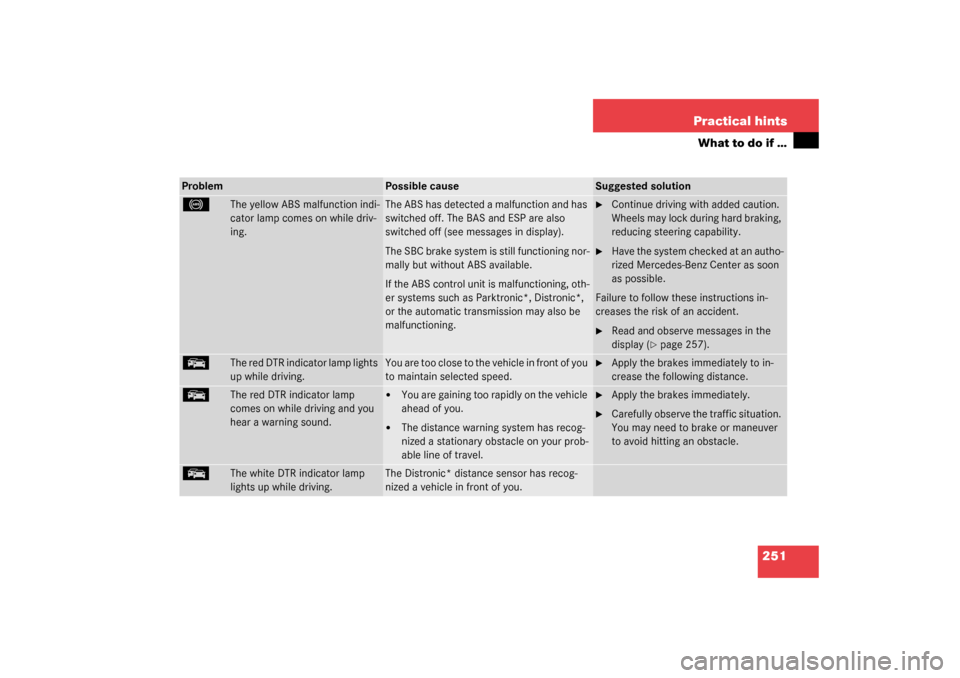
251 Practical hints
What to do if …
Problem
Possible cause
Suggested solution
-
The yellow ABS malfunction indi-
cator lamp comes on while driv-
ing.
The ABS has detected a malfunction and has
switched off. The BAS and ESP are also
switched off (see messages in display).
The SBC brake system is still functioning nor-
mally but without ABS available.
If the ABS control unit is malfunctioning, oth-
er systems such as Parktronic*, Distronic*,
or the automatic transmission may also be
malfunctioning.
�
Continue driving with added caution.
Wheels may lock during hard braking,
reducing steering capability.
�
Have the system checked at an autho-
rized Mercedes-Benz Center as soon
as possible.
Failure to follow these instructions in-
creases the risk of an accident.
�
Read and observe messages in the
display (
�page 257).
E
The red DTR indicator lamp lights
up while driving.
You are too close to the vehicle in front of you
to maintain selected speed.
�
Apply the brakes immediately to in-
crease the following distance.
E
The red DTR indicator lamp
comes on while driving and you
hear a warning sound.
�
You are gaining too rapidly on the vehicle
ahead of you.
�
The distance warning system has recog-
nized a stationary obstacle on your prob-
able line of travel.
�
Apply the brakes immediately.
�
Carefully observe the traffic situation.
You may need to brake or maneuver
to avoid hitting an obstacle.
E
The white DTR indicator lamp
lights up while driving.
The Distronic* distance sensor has recog-
nized a vehicle in front of you.
Page 252 of 376
252 Practical hintsWhat to do if …Problem
Possible cause
Suggested solution
1
The red SRS indicator lamp lights
up while driving.
There is a malfunction in the restraint sys-
tems. The airbags or emergency tensioning
device (ETD) could deploy unexpectedly or
fail to activate in an accident.
�
Drive with added caution to the near-
est authorized
Mercedes-Benz Center.
Warning!
G
In the event that a malfunction of the SRS is
indicated as outlined above, the SRS may
not be operational. For your safety, we
strongly recommend that you visit an
authorized Mercedes-Benz Center immedi-
ately to have the system checked; otherwise
the SRS may not be activated when needed
in an accident, which could result in serious
or fatal injury, or it might deploy
unexpectedly and unnecessarily which
could also result in an accident and/or
injury to you or to others.
Page 253 of 376
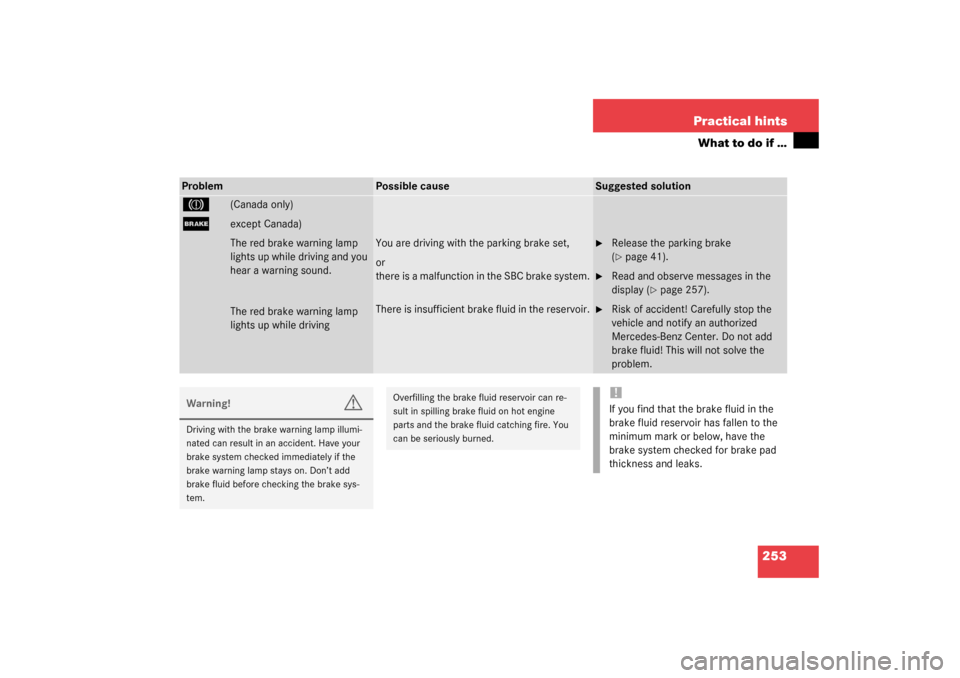
253 Practical hints
What to do if …
Problem
Possible cause
Suggested solution
3
(Canada only)
;
except Canada)
The red brake warning lamp
lights up while driving and you
hear a warning sound.
The red brake warning lamp
lights up while driving
You are driving with the parking brake set,
or
there is a malfunction in the SBC brake system.
There is insufficient brake fluid in the reservoir.
�
Release the parking brake
(�page 41).
�
Read and observe messages in the
display (
�page 257).
�
Risk of accident! Carefully stop the
vehicle and notify an authorized
Mercedes-Benz Center. Do not add
brake fluid! This will not solve the
problem.
Warning!
G
Driving with the brake warning lamp illumi-
nated can result in an accident. Have your
brake system checked immediately if the
brake warning lamp stays on. Don’t add
brake fluid before checking the brake sys-
tem.
Overfilling the brake fluid reservoir can re-
sult in spilling brake fluid on hot engine
parts and the brake fluid catching fire. You
can be seriously burned.
!If you find that the brake fluid in the
brake fluid reservoir has fallen to the
minimum mark or below, have the
brake system checked for brake pad
thickness and leaks.
Page 256 of 376
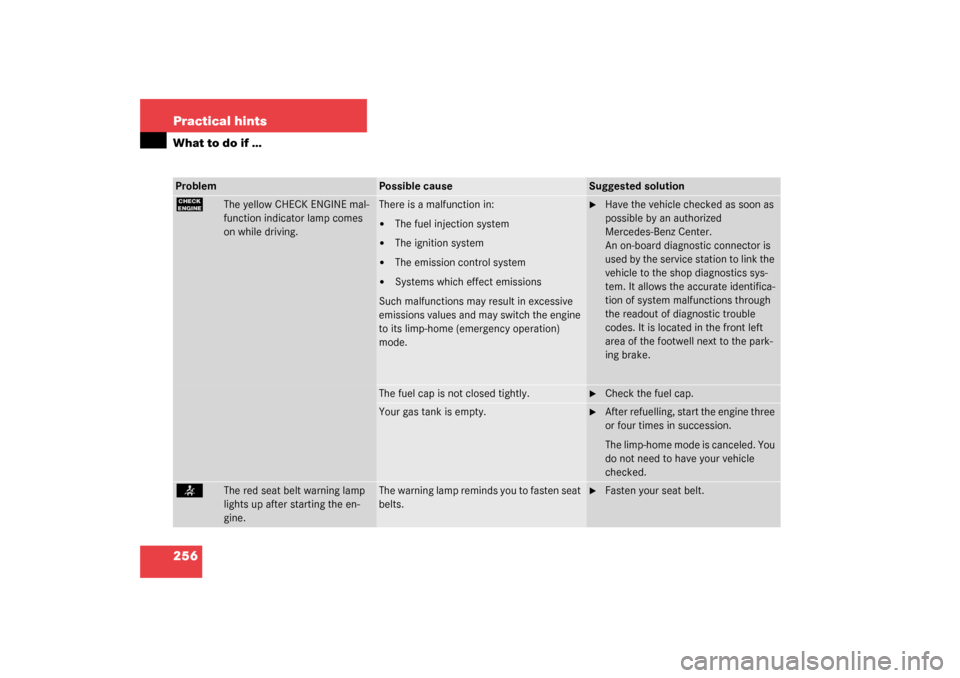
256 Practical hintsWhat to do if …Problem
Possible cause
Suggested solution
?
The yellow CHECK ENGINE mal-
function indicator lamp comes
on while driving.
There is a malfunction in:�
The fuel injection system
�
The ignition system
�
The emission control system
�
Systems which effect emissions
Such malfunctions may result in excessive
emissions values and may switch the engine
to its limp-home (emergency operation)
mode.
�
Have the vehicle checked as soon as
possible by an authorized
Mercedes-Benz Center.
An on-board diagnostic connector is
used by the service station to link the
vehicle to the shop diagnostics sys-
tem. It allows the accurate identifica-
tion of system malfunctions through
the readout of diagnostic trouble
codes. It is located in the front left
area of the footwell next to the park-
ing brake.
The fuel cap is not closed tightly.
�
Check the fuel cap.
Your gas tank is empty.
�
After refuelling, start the engine three
or four times in succession.
The limp-home mode is canceled. You
do not need to have your vehicle
checked.
<
The red seat belt warning lamp
lights up after starting the en-
gine.
The warning lamp reminds you to fasten seat
belts.
�
Fasten your seat belt.
Page 262 of 376
262 Practical hintsWhat to do if …Left display
Right display
Possible cause
Possible solution
Distronic
External fault
Reactivate!
Distronic* is switched off and is
temporarily unavailable.
�
Try activating Distronic* again later.
Clear sensor!
See Owner’s Man.
Distronic* is switched off be-
cause the Distronic* cover in the
radiator grille is dirty.
�
Clean the Distronic* cover in the radiator grille
(�page 246).
�
Restart the vehicle.
Visit workshop!
Distronic* is malfunctioning or
the display is malfunctioning.
�
Visit an authorized
Mercedes-Benz Center as soon as possible.
P
Selector lever
to P!
You have turned off the engine
with the KEYLESS-GO*
start/stop button* and opened
the driver’s door.
�
Place the selector lever in position P.
Cruise
Control
Visit workshop!
Cruise control or Distronic* is
malfunctioning.
�
Have the cruise control or Distronic* checked
by an authorized Mercedes-Benz Center.
Page 263 of 376
263 Practical hints
What to do if …
Left display
Right display
Possible cause
Possible solution
G
Display defective
The instrument cluster display is
malfunctioning.
�
Continue driving with added caution.
�
Visit an authorized Mercedes-Benz Center as
soon as possible.
L
Visit workshop!
One or more main functions of the
Tele Aid system are malfunctioning.
�
Have the Tele Aid system checked by an au-
thorized Mercedes-Benz Center.
#
Battery/Alternator
Stop vehicle!
The battery is malfunctioning.
The SBC brake system requires elec-
trical energy and therefore has only
limited operation. Considerably
greater brake pedal force is required
and the stopping distance is in-
creased.
�
S t o p t h e v e h i c l e a s s o o n a s i t i s s a f e t o d o s o .
Adjust driving to be consistent with reduced
braking responsiveness.
�
Notify an authorized Mercedes-Benz Center.